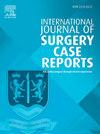Complete common mesentery revealed by a cecal bascule: Two case reports
IF 0.6
Q4 SURGERY
引用次数: 0
Abstract
Introduction
The complete common mesentery (CCM) is due to a midgut malrotation that occurs during embryonic development. Cecal volvulus (CV) is an uncommon cause of acute intestinal obstruction in this circumstance. The bascule subtype is the rarest form and happens when the cecum folds anteriorly over the ascending colon.
Cases presentation
We present two cases of acute intestinal obstruction caused by Cecal Bascule (CB) due to complete common mesentery. Notably, one patient was initially admitted wrongly for a strangulated umbilical hernia and underwent surgery without prior imaging. Both patients had open surgery consisting of a right colectomy with primary intestinal anastomosis with an uneventful recovery.
Discussion
During fetal development, the intestine rotates counterclockwise around the superior mesenteric artery. The disruption of this process leads to an anomaly called the complete common mesentery, associated with an abnormal fixation and an excessively mobile right colon positioned on the left of the abdomen. This abnormality can be revealed via a cecal volvulus with a bascule subtype, accounting for less than 10 % of all cecal volvulus. Right hemicolectomy with ileocolic anastomosis is the main treatment.
Conclusion
Complete common mesentery is a rare anomaly that can lead to serious complications, including cecal volvulus. Diagnosing this condition via abdominal CT scan can be challenging due to the modified radiological anatomy. Surgeons and radiologists must recognize this pathology. Even less experienced visceral surgeons must be aware and should remain vigilant, as one emergency can hide another.
求助全文
约1分钟内获得全文
求助全文
来源期刊
CiteScore
1.10
自引率
0.00%
发文量
1116
审稿时长
46 days

 求助内容:
求助内容: 应助结果提醒方式:
应助结果提醒方式:


